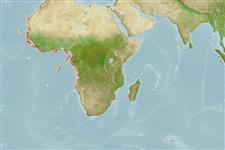Environment: milieu / climate zone / depth range / distribution range
Écologie
marin bathydémersal; non migrateur; profondeur 329 - 1261 m (Ref. 1371), usually 400 - 500 m (Ref. 1371). Deep-water; 25°N - 18°S, 22°W - 13°E (Ref. 1371)
Southeast Atlantic: southernly into the Gulf of Guinea to Angola.
Taille / Poids / Âge
Maturity: Lm ? range ? - ? cm
Max length : 25.0 cm TL mâle / non sexé; (Ref. 1371)
Description synthétique
Clés d'identification | Morphologie | Morphométrie
Épines dorsales (Total) : 2; Épines anales: 0. Ventral leading edge of snout and narrow ventromedian strip on underside naked, head otherwise completely scaled. Scales deciduous, with small, short, conical spinules in 6 to 9 parallel rows. Overall color is brownish to bluish; trunk bluish to blackish; fins blackish; mouth dusky; gill cavities blackish.
Apparently found deeper in the northern part of its range. Copepods (80%) and polychaetes (62%) have the highest proportions in specimens examined from the slope off northwestern Africa. Other crustaceans and a few fish formed the remainder of the diet. This species like the majority of macrourines, depends on a mixed diet of benthic and pelagic organisms (Ref. 6219).
Life cycle and mating behavior
Maturité | Reproduction | Frai | Œufs | Fécondité | Larves
Cohen, D.M., T. Inada, T. Iwamoto and N. Scialabba, 1990. FAO species catalogue. Vol. 10. Gadiform fishes of the world (Order Gadiformes). An annotated and illustrated catalogue of cods, hakes, grenadiers and other gadiform fishes known to date. FAO Fish. Synop. 125(10). Rome: FAO. 442 p. (Ref. 1371)
Statut dans la liste rouge de l'IUCN (Ref. 130435: Version 2024-1)
Menace pour l'homme
Harmless
Utilisations par l'homme
Pêcheries: intérêt commercial mineur
Outils
Articles particuliers
Télécharger en XML
Sources Internet
Estimates based on models
Preferred temperature (Ref.
123201): 7.1 - 9.3, mean 7.4 °C (based on 12 cells).
Phylogenetic diversity index (Ref.
82804): PD
50 = 0.5000 [Uniqueness, from 0.5 = low to 2.0 = high].
Bayesian length-weight: a=0.00214 (0.00109 - 0.00421), b=3.20 (3.03 - 3.37), in cm total length, based on LWR estimates for this (Sub)family-body shape (Ref.
93245).
Niveau trophique (Ref.
69278): 3.5 ±0.45 se; based on food items.
Résilience (Ref.
120179): Milieu, temps minimum de doublement de population : 1,4 à 4,4 années (Preliminary K or Fecundity.).
Fishing Vulnerability (Ref.
59153): Low vulnerability (15 of 100).
